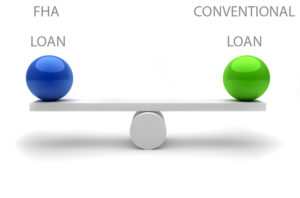
Understanding the difference between the varying home loans can help you avoid unnecessary time and expenses when you are trying to qualify for a mortgage. Two of the most commonly used loans are FHA and conventional mortgages.
There is a wide range of home loans to meet seemingly every circumstance, the challenge is choosing the right loan. This can become quite a daunting task for most people.
If you’re anything like me, the house-hunting portion of buying a home is, for the most part, enjoyable, but when it comes to talking numbers and types of loans, I’d rather not. I find the process very complicated. At some point, it becomes a big swirling mess of numbers floating around in my head.
With the help of a professional loan officer, the tornado of numbers quickly gets turned into a manageable list of mortgage loan options.
Today we are going to look at the differences between Conventional loans and Federal Housing Administration (FHA) loans. We can think of Conventional loans like driving on the highway in the HOV lane and the FHA loan like staying in the other three or four lanes during rush hour traffic. In the end, we’re all going to get there, we’re just going about it in a little different way.

Just like the HOV lane, conventional loans have certain restrictions you must follow. This loan is best for borrowers with strong credit and more liquid assets.
Conventional loans are offered by private entities such as banks, credit unions, private lenders or savings institutions and are not backed by any federal agency. If you are considering a conventional loan, keep in mind that lenders will require private mortgage insurance (PMI). This is always the case if the buyer puts less than a 20% down payment. Otherwise, the lender is liable for the full loan amount if the borrower was to default.
With a conventional loan, which includes both conforming and non-conforming loans, you can get your hands on pretty much anything from an ARM (adjustable-rate mortgage) to a 30-year fixed, and everything in between.
Now let’s get into the rush hour lanes with the FHA loans. FHA is often best when looking to minimize out of pocket cash and down payment. The major difference between the two loans is that FHA loans are insured.
FHA buyers pay upfront mortgage insurance and monthly mortgage insurance. Basically, it’s a safety net for lenders. This safety net allows lenders to borrow money to those with lower credit scores, smaller down payments, and smaller bank accounts because FHA will make them whole should the borrower default.
For instance, The FHA uses a credit score of 620 to determine whether you can qualify automatically for a loan, but a credit score below 620 does not disqualify you, as it might with a conventional mortgage.
And unlike our friend over there in the HOV lane, the conventional loan, with the FHA loan you’ll most likely be stuck with a 30-year mortgage. Every 30-year mortgage payment consists of money toward the principal amount, interest, real estate taxes, insurance, and mortgage insurance.
These days, both FHA loans and Conventional loans could make sense depending on your unique situation. Both will offer competitive mortgage rates and closing costs, so you’ll really have to do the math to determine which mortgage is best for your situation.
The Certo Team
55 N. Arizona Place
Suite #103
Chandler, AZ 85225
602-429-6789
